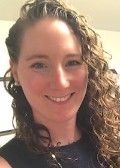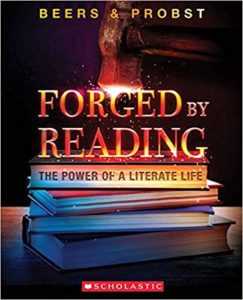Kylene Beers Independent Reading Ten Minutes a Day
Forged past Reading: The Ability of a Literate Life
By Kylene Beers and Bob Probst
(Scholastic, 2020 – Learn more)
Reviewed past Katie Durkin
 The assault on the Capitol Edifice on Jan 6, 2021 stunned our nation. Teachers were chosen to activity to assistance students understand, reflect, and grapple with this event.
The assault on the Capitol Edifice on Jan 6, 2021 stunned our nation. Teachers were chosen to activity to assistance students understand, reflect, and grapple with this event.
If Kylene Beers and Bob Probst were still writing their new book, Forged by Reading: The Power of a Literate Life, I'm certain they would have discussed how these events, and those that preceded and followed it, were continued with the power of reading.
 Dividing their book into 3 parts – Change, Power, and Hope, the widely respected literacy educators continue sharing their expertise with teachers about how reading and writing tin mold students into their future selves.
Dividing their book into 3 parts – Change, Power, and Hope, the widely respected literacy educators continue sharing their expertise with teachers about how reading and writing tin mold students into their future selves.
Using examples from their past practices and schoolhouse visits, Beers and Probst center their discussion on the power of reading and writing and how "…our give-and-take as a nation needs to be most how reading and writing tin offering students the power to change themselves and perhaps the earth around them" (p. 9).
Part One: Change focuses on how reading and writing bring about alter in our world. By teaching students how we tin can employ these "tools of literacy," we are empowering them to change themselves, their communities and the globe (p. 9). Beers and Probst enquire teachers to think most the means we tin change our thinking on how nosotros teach reading.
I chapter is dedicated to an anecdote about a school visit where they encountered a pupil, Lily, a beginning reader. Lily was able to demonstrate her ability to read well, even speaking aloud many of her internal thoughts about the story. Merely when she mispronounced a fictitious word, she was chastised by a coach, stating she was not prepare to read the book.
Beers and Probst use this example, and others, to ask an important question: "What if our start vision of reading is that reading empowers children to become all they tin be and so they can forge a ameliorate life for themselves, their community, and their commonwealth?" (p. 54)
This one instance shows how Beers and Probst saw the need for alter within a organization to rethink how the system views reading practices and skills. Alter must commencement with the teacher, the school, and the community, recognizing the power of literacy and how we can back up students to use their literacy skills to enact positive change.
Function Ii: Power begins with examples from our nation's history on how white people attempted to go along the power of literacy, and instruction, to themselves, denying Black Americans, Start Nations people, and Latino-Americans the privilege of this power.
These conversations, and many others, may cause discomfort, merely Beers and Probst argue this discomfort is necessary to agreement that a instructor'southward goal should be "to help students think almost significant issues, possibly change themselves, and perhaps fifty-fifty become activists who help others evolve and abound" (p.79).
Books are tools that tin can assist students ask these tough questions in guild to think nigh how they change themselves and their world, and we must push students to read rigorous texts and study issues that matter to them.
Part Three: Hope brings the ideas of the previous two sections together by providing strategies teachers tin utilise to empower students to recognize how they tin can employ the power of literacy to create positive change. This promise for the futurity also depends on whether and how teachers can change themselves.
Beers and Probst discuss independent readers, answering 10 important questions almost how this reading functions for our students. These questions range from answering how many minutes students should read a day to how many books a teacher should have in his/her classroom.
The authors talk over choice, reluctant readers, censorship, and barriers that may exist for teachers when making fourth dimension for independent reading, all while offer solutions for teachers to use when faced with these obstacles. They offer the revised "BHHD" strategy, kickoff introduced in their book, Disrupting Thinking, where students are asked:
- "What's in the book?
- What'due south in your head?
- What's in your heart?
- What will yous do now?" (p. 178)
Past calculation the last question, this strategy asks students to think about how they are empowered past their reading and how this work may inspire them to change themselves and the globe.
In the terminal affiliate, Forging Alee , Beers and Probst name immature adults who have used literacy to create change and claiming inequities in both smaller and larger communities. They provide examples and models for students, but besides for teachers, to begin to change how literacy functions within the microcosm of the classroom.
Beers and Probst end with a call to activeness: "You, our nation's teachers, have the power to help students become empowered readers and thinkers. You can help each student forge his or her life through reading. So again, dear teachers, we turn to y'all" (p. 193).
Reasons for reading Forged by Reading
I highly recommend this book for any teacher who would similar to reflect upon and ameliorate understand the power of literacy. The many insights from these professionals, as well as gear up-to-utilise strategies, can help teachers think about how reading and writing chronicle to change, ability, and promise.
For me, this book affirmed much of my pedagogy and my didactics practices, but it also helped me to empathize that the work of a instructor is never done. Similar to our students, we must continually acquire and read and reverberate in order to empower ourselves and the current and future young people in our professional care.
Through this book, I appreciate how I can be empowered by reading. I am empowered to brand alter for my students because of Beers and Probst'southward words and continue to model and forge a time to come, using the tools of literacy, for myself and my students.
Katie Durkin (@kmerz610) has been instruction English Language Arts to centre schoolhouse students for a decade and currently teaches 7th grade Reading Workshop at public Middlebrook Schoolhouse in Wilton, Connecticut.
Katie is a zealous reader of middle grades and young developed books and enjoys sharing her love and passion for reading with her students. She is a doctoral student at Northeastern Academy studying the impact of classroom libraries on middle school students' reading engagement. She is the 2020 recipient of the Edwyna Wheadon Postgraduate Training Scholarship from the National Council of Teachers of English language.
Source: https://www.middleweb.com/44939/help-students-grasp-literacys-power-hope/
0 Response to "Kylene Beers Independent Reading Ten Minutes a Day"
Postar um comentário